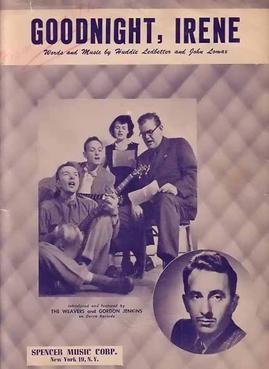Song by Lead Belly
Released 1943
Genre Folk
Length 2:25
“Goodnight, Irene” or “Irene, Goodnight,” is a 20th-century American folk standard, written in 3/4 time, first recorded by American blues musician Huddie ‘Lead Belly’ Ledbetter in 1933.
The lyrics tell of the singer’s troubled past with his love, Irene, and express his sadness and frustration. Several verses make explicit references to suicidal fantasies, most famously in the line “sometimes I take a great notion to jump in the river and drown,” which was the inspiration for the 1964 Ken Kesey novel Sometimes a Great Notion and a song of the same name from John Mellencamp’s 1989 album, Big Daddy, itself strongly informed by traditional American folk music.
The specific origins of “Irene” are unclear. Lead Belly was singing a version of the song from as early as 1908, which he claimed to have learned from his uncles Terell and Bob. An 1892 song by Gussie L. Davis has several lyrical and structural similarities to the latter song; a copy of the sheet music is available from the Library of Congress. Some evidence suggests the 1892 song was itself based on an even earlier song which has not survived. Regardless of where he first heard it, by the 1930s Lead Belly had made the song his own, modifying the rhythm and rewriting most of the verses.
Lead Belly continued performing the song during his various prison terms, and it was while incarcerated at the Louisiana State Penitentiary that he encountered musicologists John and Alan Lomax who would go on to record hours of Lead Belly’s performances. A few months prior to his release in 1934, Lead Belly recorded a number of his songs, including “Irene”, for the Library of Congress. An extended version of the song that includes narratives connecting the verses appears in Negro Folk Songs as Sung by Lead Belly.[4] “Irene” remained a staple of Lead Belly’s performances throughout the 1930s and ’40s. However, despite popularity within the New York blues community, the song was never commercially successful during his lifetime. In 2002, Lead Belly’s 1936 Library of Congress recording received a Grammy Hall of Fame Award.
Covers
In 1950, one year after Leadbelly’s death, the American folk band The Weavers recorded a version of “Goodnight, Irene”. The single first reached the Billboard Best Seller chart on June 30, 1950 and lasted 25 weeks on the chart, peaking at #1 for 13 weeks. Although generally faithful, the Weavers chose to omit some of Leadbelly’s more controversial lyrics, leading Time magazine to label it a “dehydrated” and “prettied up” version of the original. Due to the recording’s popularity, however, The Weavers’ lyrics are the ones generally used today. Billboard ranked this version as the No. 1 song of 1950.
The Weavers’ enormous success inspired many other artists to release their own versions of the song, many of which were themselves commercially successful across several genres. Frank Sinatra’s cover, released only a month after The Weavers’, lasted nine weeks on the Billboard magazine Best Seller chart on July 10, peaking at #5. Later that same year, Ernest Tubb and Red Foley had a #1 country music record with the song, and the Alexander Brothers, Dennis Day and Jo Stafford released versions which made the Best Seller chart, peaking at #26, #17 and #9 respectively. Moon Mullican had a number 5 country hit with it in 1950, and a version by Paul Gayten and his Orchestra reached number 6 on the Billboard R&B chart in the same year
On the Cash Box chart, where all available versions were combined in the standings, the song reached a peak position of #1 on September 2, 1950, and lasted at #1 for 13 weeks.
The song was the basis for the 1950 parody called “Please Say Goodnight to the Guy, Irene” by Ziggy Talent. It also inspired the 1954 “answer” record “Wake Up, Irene” by Hank Thompson, a #1 on Billboard’s country chart.
Other hit versions
1959: Billy Williams reached number 75 on the US Billboard pop chart.
1962: Jerry Reed reached number 79 on the US pop chart.

